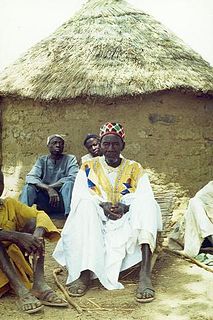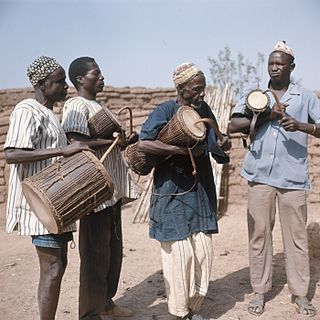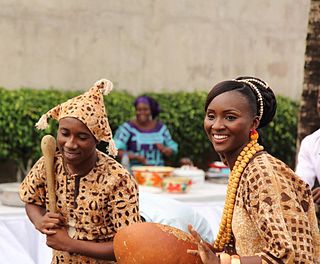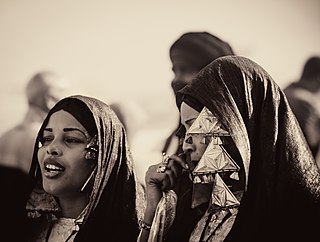 W
WBerbers or Imazighen are an ethnic group who are indigenous to North Africa, specifically Morocco, Algeria, Tunisia, Libya, the Canary Islands, and to a lesser extent in Mauritania, northern Mali, and northern Niger. Smaller Berber populations are also found in Burkina Faso and Egypt's Siwa Oasis. Historically, Berber nations spoke the Berber languages, which are a branch of the Afroasiatic language family.
 W
WThe Bobo are a Mande ethnic group living primarily in Burkina Faso, with some living north in Mali. Bobo is also a shortened name of the second-largest city in Burkina Faso, Bobo-Dioulasso.
 W
WThe Fula, Fulani, or Fulɓe people are one of the largest ethnic groups in the Sahel and West Africa, widely dispersed across the region. Inhabiting many countries, they live mainly in West Africa and northern parts of Central Africa but also in South Sudan, Darfur, Eritrea, and regions near the Red Sea coast. The approximate number of Fula people is unknown due to clashing definitions regarding Fula ethnicity; various estimates put the figure between 55 and 69.2 million worldwide.
 W
WGurma is an ethnic group living mainly in northeastern Ghana, Burkina Faso, around Fada N'Gourma, and also in northern areas of Togo and Benin, as well as southwestern Niger. They number approximately 1,750,000.
 W
WThe Iwellemmedan (Iwəlləmədǎn), also spelled Iullemmeden, Aulliminden, Ouilliminden, Lullemmeden, and Iwellemmeden, are one of the seven major Tuareg tribal or clan confederations. Their communities are historically nomadic and intermixed with other ethnic groups. The Iwellemmeden inhabit a wide area ranging from east and north central Mali, through the Azawagh valley, into northwestern Niger and south into northern Nigeria. While once a single confederation of dozens of Tuareg clans, subject peoples, and allied groups, since the 18th century they have been divided into Kel Ataram (west) and Kel Dinnik (east) confederations. Following colonial rule and independence, the Iwellemmedan homelands cross the Mali/Niger border, and their traditional seasonal migration routes have spread Iwellemmedan communities into Burkina Faso and Nigeria as well. They speak the Tawellemmet variant of the Tamasheq language, although some current or historical sub-clans speak other Tamasheq variants as well as Songhai languages and Arabic dialects.
 W
WThe Mandinka or Malinke are a West African ethnic group primarily found in southern Mali, the Gambia, eastern Guinea and northern Ivory Coast. Numbering about 11 million, they are the largest subgroup of the Mandé peoples and one of the largest ethnic-linguistic groups in Africa. They speak the Manding languages in the Mande language family and a lingua franca in much of West Africa. Over 99% of Mandinka adhere to Islam. They are predominantly subsistence farmers and live in rural villages. Their largest urban center is Bamako, the capital of Mali.
 W
WThe Mossi are a Gur ethnic group native to modern Burkina Faso, primarily the Volta River basin. The Mossi are the largest ethnic group in Burkina Faso, constituting 52% of the population, or about 11.1 million people. The other 48% of Burkina Faso's population is composed of more than 60 ethnic groups, mainly the Gurunsi, Senufo, Lobi, Bobo and Fulani. The Mossi speak the Mòoré language.
 W
WThe Nuna people, or Nunuma, are subgroup of the Gurunsi people in Southern Burkina Faso, estimated 150,000 population, and Ghana. The Nuna are known for their masks. The group speaks the Nuni language.
 W
WThe Samo is a sub-ethnic group of the Mandinka people from West Africa. They mainly live in northwest Burkina Faso and across the border in southern Mali.
 W
WThe Senufo people, also known as Siena, Senefo, Sene, Senoufo, and Syénambélé, are a West African ethnolinguistic group. They consist of diverse subgroups living in a region spanning the northern Ivory Coast, the southeastern Mali and the western Burkina Faso. One sub-group, the Nafana, is found in north-western Ghana.
 W
WThe Soninke people are a West African Mande-speaking ethnic group found in eastern Senegal and its capital Dakar, northwestern Mali and Fouta Djallon in Guinea, The Gambia and southern Mauritania. They speak the Soninke language, also called Maraka language, which is one of the Mande languages. Soninke people were the founders of the ancient empire of Ghana c. 750–1240 CE. Subgroups of Soninke include the Maraka and Wangara. When the Ghana empire was destroyed, the resulting diaspora brought Soninkes to Mali, Senegal, Mauritania, Gambia, Burkina Faso, Côte d'Ivoire, Guinée-Conakry, modern-day Republic of Ghana, and Guinea-Bissau where some of this trading diaspora was called Wangara.
 W
WThe Tellem were the people who inhabited the Bandiagara Escarpment in Mali between the 11th and 16th centuries CE. The Dogon people migrated to the escarpment region around the 14th century. In the rock cells of this red cliff, clay constructions shelter the bones of the Tellem as well as vestiges witnessing their civilization, well before that of the Dogons.
 W
WToloy is the name given to the first occupants of the Bandiagara Escarpment in Mali. Since the 15th century, this area has been known as Dogon country.
 W
WThe Tuareg people are a large Berber ethnic group that principally inhabit the Sahara in a vast area stretching from far southwestern Libya to southern Algeria, Niger, Mali and Burkina Faso. Traditionally nomadic pastoralists, small groups of Tuareg are also found in northern Nigeria.
 W
WThe Turka are an ethnic group in Burkina Faso. They are part of the Gur people and speak the Turka language ("tuz"), a Gur language. The Turka population is estimated at 48,000-61,000.
 W
WThe Zarma people are an ethnic group predominantly found in westernmost Niger. They are also found in significant numbers in the adjacent areas of Nigeria and Benin, along with smaller numbers in Burkina Faso, Ivory Coast, Ghana, Togo, and Cameroon.